Charting a pedagogical course through stormy seas
by Victoria Jefferies Sea state: rough, occasionally very rough, rarely smooth! It’s rarely plain sailing in Early Childhood Education and Care (ECEC) with its myriad
Clare Devlin, Early Education Associate
What aspects of physical development should we focus on within the Early Years Foundation Stage (EYFS) and other early years curricula? In this article, I explore the importance of physicality at this crucial point in a child’s development. The article explores two key aspects, “moving and handling” and “self-care”. It defines the key terms and illustrates the ways in which children can be supported to grow and develop in themselves.
Moving generally refers to how children move with their whole bodies, mostly through gross or large motor movements such as running, rolling, and jumping. Handling has more to do with our fine or small motor movements such as pinching, mark-making, and threading. This article will explore why both types of movements are vitally important for children’s physical and holistic development, whilst also acknowledging that physical development extends beyond just gross and fine motor skills. Furthermore, it will address some of the strategies that we can use to nurture the development of these fundamental skills in our youngest children.
When we use the term “self-care”, we are referring to how we support children to look after themselves and their basic needs in order to survive and thrive.
What we have learned from much research is that young children are driven to move; moving and handling are among their most natural learning mechanisms. Why is this so important and why do young children need to move so much? Firstly, it is knowing that young children move to learn as well as learn to move. Children’s movement contributes to their gross motor development, and there are three large gross motor movements that are of significance in the early years, namely: Cross Lateral Movement; Balance and Coordination (Vestibular Development); and Deep Sensory Awareness (Proprioception & Interoception).
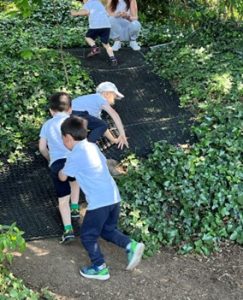 Cross Lateral Movement is when we use both sides of the body in tandem, and when the movement crosses the midline of the body. Creeping, crawling, clambering, running, walking, and pedalling all support cross lateral movement and development, helping our hands, arms, legs, feet, and eyes all work together. When young children have regular access to these basic movements then it is more likely that they will develop stronger connections between the two sides of the brain. When this happens, then the capacity for more complex sensory processing grows, enabling children to become more adept at sequencing thoughts and words which in turn supports co-ordination and sequencing of speech, communication, and early writing. Eventually, it will support children’s ability to visually track and read print within the environment, such as on billboards, packaging, on notice boards and in books. Daily doses of cross lateral movement are so good for children’s physical and psychological development.
Cross Lateral Movement is when we use both sides of the body in tandem, and when the movement crosses the midline of the body. Creeping, crawling, clambering, running, walking, and pedalling all support cross lateral movement and development, helping our hands, arms, legs, feet, and eyes all work together. When young children have regular access to these basic movements then it is more likely that they will develop stronger connections between the two sides of the brain. When this happens, then the capacity for more complex sensory processing grows, enabling children to become more adept at sequencing thoughts and words which in turn supports co-ordination and sequencing of speech, communication, and early writing. Eventually, it will support children’s ability to visually track and read print within the environment, such as on billboards, packaging, on notice boards and in books. Daily doses of cross lateral movement are so good for children’s physical and psychological development.
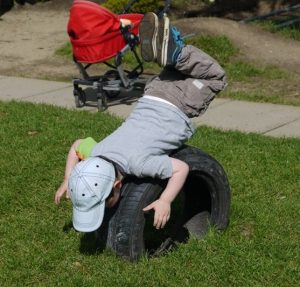 Balance and Coordination are supported via the vestibular system which provides information through the inner ear. The vestibular system is stimulated by the movement of fluid in the inner ear in response to movement by the head. In order to have a strong sense of balance and coordination children need to move lots: rock, roll, spin, tip, tilt and jump. These various actions have been described as Boing! Whoosh! RolyPoly! by some, for the sorts of movements they describe.
Balance and Coordination are supported via the vestibular system which provides information through the inner ear. The vestibular system is stimulated by the movement of fluid in the inner ear in response to movement by the head. In order to have a strong sense of balance and coordination children need to move lots: rock, roll, spin, tip, tilt and jump. These various actions have been described as Boing! Whoosh! RolyPoly! by some, for the sorts of movements they describe.
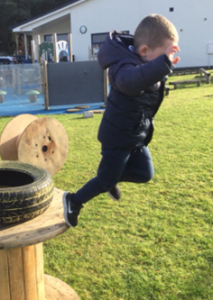 When children have plenty of access to these types of movements then they are more likely to be able to self-regulate their bodies and pay attention for longer periods of time. When children cannot sit still to listen to a story, then this may be an indicator that their vestibular system is not yet fully developed and they will need more time for such movements. If you observe children in the home, you may notice that they rarely watch the television or listen to a story with their legs crossed and arms folded! They regularly have their feet resting above their head or some may even prop themselves upside down before they can fully pay attention. They are trying to self-regulate their own bodies and their ability to stay focused. Many early years practitioners now see the value of offering this type of rhythmic movement activity to children before inviting them to engage in story time and more sedentary activities where greater focus and attention is required.
When children have plenty of access to these types of movements then they are more likely to be able to self-regulate their bodies and pay attention for longer periods of time. When children cannot sit still to listen to a story, then this may be an indicator that their vestibular system is not yet fully developed and they will need more time for such movements. If you observe children in the home, you may notice that they rarely watch the television or listen to a story with their legs crossed and arms folded! They regularly have their feet resting above their head or some may even prop themselves upside down before they can fully pay attention. They are trying to self-regulate their own bodies and their ability to stay focused. Many early years practitioners now see the value of offering this type of rhythmic movement activity to children before inviting them to engage in story time and more sedentary activities where greater focus and attention is required.
Deep Sensory Awareness (Proprioception) is all about knowing where our bodies are in space; knowing where our body parts and endings are without having to look for them. This is really important for strong body coordination and spatial awareness. It also includes an understanding of how much pressure to apply when we go to lift an item, or when we apply pressure to a writing tool. Very young children will often misjudge how much pressure to apply to a tumbler of water. They will swipe too fast and knock the tumbler over; or they may not put enough pressure on the tumbler, again resulting in spillage. Likewise, when they are making marks, they may appear to be digging holes in the page with their writing tool or perhaps they just make little spidery marks. When we see this, we know that children’s deep sensory systems are not yet fully developed.
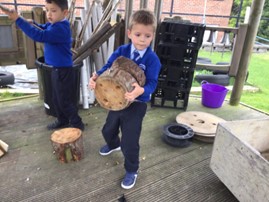 We need to offer children more opportunities for lifting, carrying, holding, pushing, and pulling big, heavy, and awkward items. All of this work builds up an awareness of pressure and how much pressure to apply. Working with big, heavy, and awkward equipment also supports children’s spatial awareness and reasoning, an important lifelong mathematical skill that is required by all.
We need to offer children more opportunities for lifting, carrying, holding, pushing, and pulling big, heavy, and awkward items. All of this work builds up an awareness of pressure and how much pressure to apply. Working with big, heavy, and awkward equipment also supports children’s spatial awareness and reasoning, an important lifelong mathematical skill that is required by all.  In order to lift and transport this type of equipment, children have to think about the weight of the items, how many can they lift, how long their arms are in relation to the pieces, how far can they travel with this weight, the size of the turning circle available to them, how high they will need to lift the equipment in order to take it out of containers, and how high they need to carry the object above their head so that they do not hit another child. There are so many mathematical considerations here along with lots of opportunity for critical thinking and problem-solving skills, which can be developed so readily in a richly resourced outdoor environment.
In order to lift and transport this type of equipment, children have to think about the weight of the items, how many can they lift, how long their arms are in relation to the pieces, how far can they travel with this weight, the size of the turning circle available to them, how high they will need to lift the equipment in order to take it out of containers, and how high they need to carry the object above their head so that they do not hit another child. There are so many mathematical considerations here along with lots of opportunity for critical thinking and problem-solving skills, which can be developed so readily in a richly resourced outdoor environment.
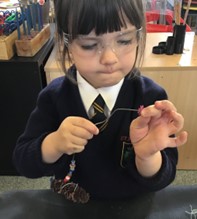
 Handling or fine motor development is an umbrella term used by many practitioners to refer to smaller physical movements such as hand muscle development, palmer grasp, wrist movement, pincer control, and hand eye coordination. Good fine motor development supports children’s independence in doing a range of important everyday tasks such as eating, getting dressed, manipulating small objects, and writing.
Handling or fine motor development is an umbrella term used by many practitioners to refer to smaller physical movements such as hand muscle development, palmer grasp, wrist movement, pincer control, and hand eye coordination. Good fine motor development supports children’s independence in doing a range of important everyday tasks such as eating, getting dressed, manipulating small objects, and writing.
There are many activities that we can offer to children in order to strengthen their fine motor control, such as working with wire and tools, stretching elastic bands, squeezing and pressing dough. I prefer to use clay which is more resistant to pressure, making it more challenging and satisfying. Mashing, grinding, and whisking in the mud station are also superb ways to build up stronger muscle tone. A variety of loose parts can offer a range of handling opportunities.
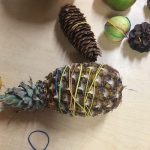
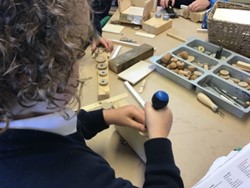 The more specific that we can be in our observations and assessment of children’s physical development means that we can target our interventions, resources, and experiences more accurately to support improvement and development. For example, hand eye coordination and pincer development require tasks such as intricate threading of wire and working with more complex tools.
The more specific that we can be in our observations and assessment of children’s physical development means that we can target our interventions, resources, and experiences more accurately to support improvement and development. For example, hand eye coordination and pincer development require tasks such as intricate threading of wire and working with more complex tools.
Developing good self-care is all about being able to manage and look after oneself in the everyday world. In the very early years children are learning to feed themselves, drink when thirsty, manage hand washing, toileting, and nose cleaning. They should have many opportunities to learn about and develop their own basic hygiene and personal needs such as how to keep healthy through exercise, good sleep routines, and positive lifestyle choices. It is also important that children learn how to recognise danger and know when to seek help.
All of these incredibly important skills are learned and absorbed through well planned daily routines. Where children are very confident and competent in their physical and health care skills, there is a strong commitment and sustained approach to self-care adopted by very tuned in adults.
Planning for physical development does not need to be complicated. It can be incorporated into everyday activities. Be clear about the skills and aspects of development that you wish to promote and support children with. Then, check that your environment and resources support the desired development. I do not try to link any of this core development work to a topic. Often in our anxiety to teach to a topic, we lose sight of what children need support with. Watch and observe the children closely. They will tell you through their everyday ordinary behaviour what they require. Incorporate your observations and assessments into your planning and keep all of the experiences meaningful.
In conclusion, physical development is vitally important for our health and wellbeing. In addition to becoming stronger, physical activity also impacts greatly on the social, emotional, and cognitive development of children. Physical activity in early childhood lays the foundations for a more active and healthy life. We also know that children will be more naturally active when they are outdoors – there may be opportunities for enhancing physicality locally, such as in places like the park, that require little or no equipment. You may consider the landscape of your setting or your locality for the sorts of spaces that might offer new opportunities for physical development. Giving children a breadth of opportunities for engaging in physical activities helps to support their development in a range of ways, and – as educators, there are countless possibilities for us to help facilitate children’s growth and development through our practice, provision, and the experiences we offer.
Clare Devlin is an Associate of Early Education, with 35 years of experience in the field. As a trainer and consultant, Clare works with a range of organisations and providers across the statutory, voluntary, and private sector in addition to providing support to individual practitioners, teachers, parents, professionals and advisers working within the early years sector.
Our thanks to the following for photo permissions: Little Treasures Day Nursery, Limavady, Co Derry; St Clare’s Abbey Nursery Unit, Newry, Co Down; St Eoghan’s Primary School, Moneyneena, Co Derry; Giggles Early Years, Newry, Co Down.

by Victoria Jefferies Sea state: rough, occasionally very rough, rarely smooth! It’s rarely plain sailing in Early Childhood Education and Care (ECEC) with its myriad
by Natalie Weir and Janine Coates In March 2023, the National Early Years Active Start Partnership (NEYASP) was established to address pressing issues surrounding physical
The letter below sets out our key asks for the next government.
Early Education Associate, Debi Keyte-Hartland reflects on a recent commission by Balcarras Teaching School Hub In Gloucestershire to deliver a four-day course on Sustained Shared
DfE have issued an update to address the issue of parents wishing to claim their codes for the new entitlements who cannot do so because
by Frances Giampapa and Claire Lee Introduction A wealth of evidence demonstrates the fundamental role played by early years (EY) education in shaping a thriving
UK early years curricula England The Early Years Foundation Stage statutory framework applies in England for early years provision for children from birth to 5.
The Department for Education has today published the two versions of the EYFS Statutory Framework which will apply from 4 January 2024: These incorporate the
The Department for Education has today published its response to the EYFS consultation conducted in the summer. The changes will be implemented from January 2024
by Katherine Gulliver Introduction Early Education was recently asked to review the special educational needs and/or disabilities (SEND) provision in the early years within one
By Debi Keyte-Hartland, Early Education Associate This article is based on one included in the Early Education Journal no 100. To access the full article
In this article, Kate Irvine from Bristol Early Years discusses the impact of practitioners engaging in a sustained process of CPD through cluster groups and
by Dr Jo Albin-Clark, Edge Hill University and Dr Nathan Archer, Leeds Beckett University Inspection in the news Being involved in education in England involves
The Department for Education (DfE) have published their response to the consultation on potential changes to staff:child ratios. The consultation received responses from nearly 10,000
by Anni McTavish What are treasure baskets? “Treasure Baskets” are a collection of ordinary household objects, that are chosen to offer variety and fascination for
by Debi Keyte- Hartland The term “Loose Parts” was coined by Simon Nicholson, a British architect and designer whose parents were artists Barbara Hepworth and
by Helen J Williams Early mathematics is essential for children’s full development, it is also predictive of later, wider achievement. Early mathematical learning is critical
by Kathryn Solly The benefits of outdoor learning in the early years have now been firmly recognised for both educators and young children’s learning and
What is continuous provision in EYFS? By Ben White Continuous provision in EYFS refers to the resources and learning opportunities accessible to children all of
What are “Fundamental British Values”? by Vicky Hutchin The so-called “Fundamental British Values” form a part of the Prevent Duty, introduced in 2015 and last
The open letter below was sent to Ofsted in November 2023. Download Ofsted’s response We the undersigned are writing to you about the recently published
Early childhood education today has been influenced by key figures such as Froebel, Montessori, Isaacs and MacMillan. Much recent research has supported their ideas although
The Families’ Access to Nature Project was undertaken by the Froebel Trust and Early Education between October 2021 and January 2022. Children, their parents, and
by Leslie Patterson At the very beginning of the 1970s I was lucky enough to attend a playschool, at a time when there was very
Guest blog by Sara Knight Why are opportunities for risk and adventure essential for normal development in the early years? Tim Gill (2007) identifies four
Guest blog from Dr Elizabeth Byrne, University of Cambridge Most educators will be aware that “what works” in support of children’s learning and development is
Why go outside? Big movers Have you ever been in an open space with young children? The first thing they want to do is to
Taking care of a baby is tiring work, with a lot of feeding, nappies and broken nights. When you are exhausted, it can be harder
Sustained shared thinking: An episode in which two or more individuals “work together” in an intellectual way to solve a problem, clarify a concept, evaluate
Early years pedagogy is the theory that informs the practice of teaching children in the early years. The pedagogical research has been carried out by
by Cathy Gunning What is reflective practice? Reading a book by Donald Schon early on in my career as a teacher opened my eyes to
Here are some links to resources to support your play. Loose parts play tookit is such a rich and comprehensive free publication from Inspiring Scotland to
The Early Career Framework has been designed by the Department for Education in England to support newly qualified teachers in England with a structured package of support
The following extracts from past early years teaching newsletters have a feature which supports your team dialogue around pedagogy and practice dilemmas and reflective practice.
When writing our January Early Years Teaching News, I tweeted a survey to ask if practitioners and leaders would like information about ICT or outside
Last updated Spring 2018. The preschools of the Reggio Emilia in Northern Italy inspire us with their pedagogy and practice in giving children rich encounters
In most cases, sound early years principles and practices are already in place in settings. The EYPP funding allows settings to review and refine what
Who was Friedrich Froebel (1782-1852) Born on 21 April 1782 Friedrich Froebel was a German educator who invented the kindergarten. He believed that “play is
This content by Jan White comes from our out of print leaflet “The Sky is the Limit: Babies and Toddlers Outdoors: developing thinking, provision and practice”
This article by Early Education Associate Anni McTavish explores the term “cultural capital”, and what it might mean for early years practitioners and their settings.
Welcome to the e-book Child-Centred Competences for Early Childhood Education and Care. The book brings together four years of research undertaken by early childhood academics
Raymond Williams maintained, after years of examining constructs of culture and society that “Culture is one of the two or three most complicated words in
Healthy settling for high wellbeing How can we best help children feel at ease so that they are secure and settled in their new provision?









Early Education
2 Victoria Square
St Albans
AL1 3TF
T: 01727 884925
E: office@early-education.org.uk